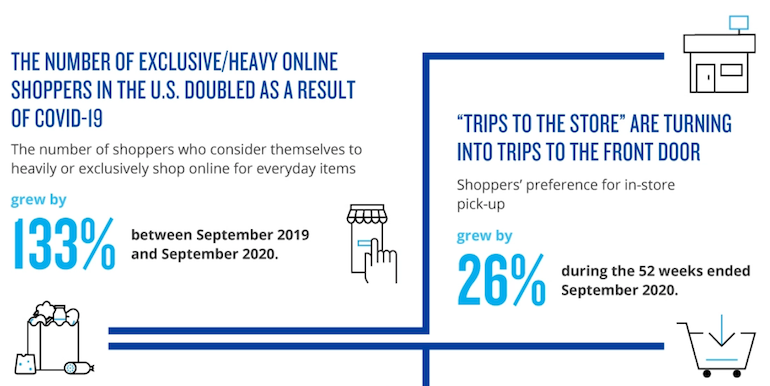This year, U.S. omnichannel consumption swelled by 50%, and nearly half of all consumer goods purchases were made via e-commerce, according to new research from Nielsen.
Both food and nonfood products have seen marked shifts in omnichannel shopping since the COVID-19 outbreak in the first quarter of 2020, Chicago-based Nielsen said this week in releasing its latest Omnichannel Shopping Fundamentals survey. For example, the number of shoppers who deem themselves as “heavy” or “exclusive” online shoppers for everyday items jumped 133% from September 2019 to September 2020.
Similarly, trips to the store are becoming “trips to the front door,” Nielsen noted. The study revealed that U.S. consumers’ preference for in-store pickup of items ordered online grew by 26% during the 52 weeks ended in September 2020.

Nielsen’s Omnichannel Fundamentals Survey captures purchasing trends of fast-moving consumer goods (FMCG) both before and since the coronavirus pandemic. The market researcher said the study was fielded in September 2019 (pre-pandemic), April 2020 (during the lockdown phase) and September 2020 (in the “new normal” consumer landscape). Almost 25,000 surveys were fielded per wave in Nielsen’s nationally representative Homescan panel, and insights on more than 150,000 “category transactions” per wave were collected for the survey.
“Within the U.S., new behaviors have emerged that retailers and manufacturers must acknowledge, accommodate and swiftly act on — especially as online shopping habits begin to solidify,” Nikhil Sharma, vice president of North America consumer analytics at Nielsen, said in a statement. “While we do expect a return of some kind to pre-pandemic habits, consumers will not be returning to a pre-pandemic retail environment.”
Looking at consumer engagement across channels, Nielsen found in its latest omnichannel research that 56% of online shoppers “put careful consideration” into each purchase at the point of sale, compared with 51% of brick-and-mortar shoppers.
That trend also goes for online grocery transactions. “Online shoppers became more invested than their brick-and-mortar counterparts in searching for the best product to fit new needs and, as a result, increased planning efforts for online grocery purchases into the ‘new normal,’” Nielsen reported. “When examining planning levels for in-store food purchases, rates of purchase planning dipped below pre-COVID levels by September 2020. And as brick-and-mortar shoppers eased up on planning efforts, impulse purchasing for food and nonfood products increased slightly across offline channels.”
The September 2020 findings also show that “omnicentric categories are budding,” according to Nielsen. These product segments center on nonfood items, led by pet supplies (85% purchased online), vitamins (79% purchased online) and facial skin care (78% purchased online).
“Nonfood categories like pet supplies, vitamins and facial skin care are performing exceedingly well across the omnichannel landscape,” Nielsen stated.
On the demographic side of the equation, the number of Hispanics, African-Americans and Asian-Americans who used both online and offline fulfillment methods escalated during the pandemic. Through the end of September, omnichannel adoption rose 54% among Hispanic shoppers, compared with 43% for African-Americans and 31% for Asian-Americans.
And when making online transactions, 29% of consumers polled by Nielsen found the order history tool to be the most helpful feature when shopping for nonfood items.
“Undeniably, consumers have more choices than ever in their path to purchase,” Sharma added, “meaning as consumer needs and preferences continue to evolve, it is crucial to have an omnichannel strategy in place to sustain and grow momentum in 2021.”





